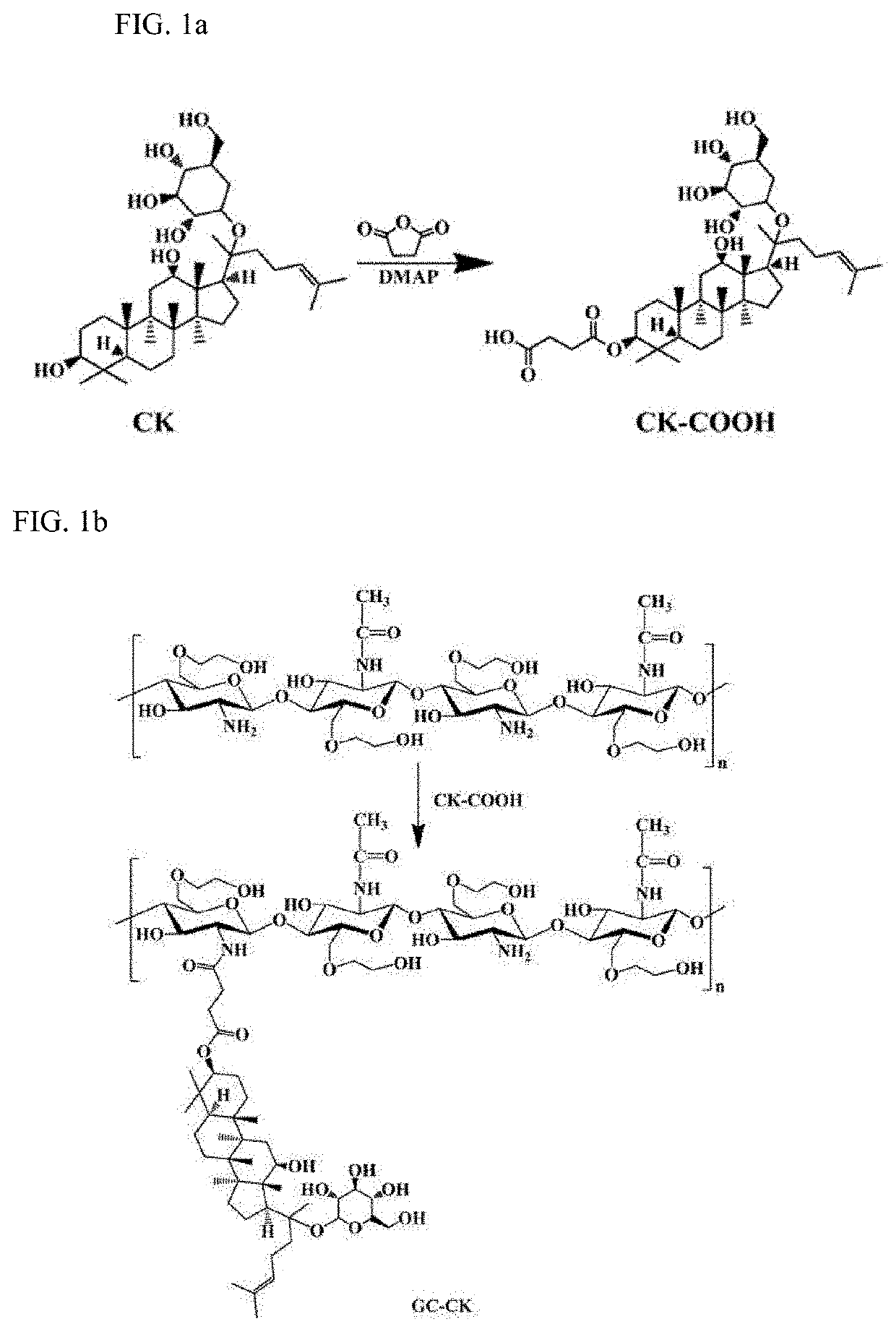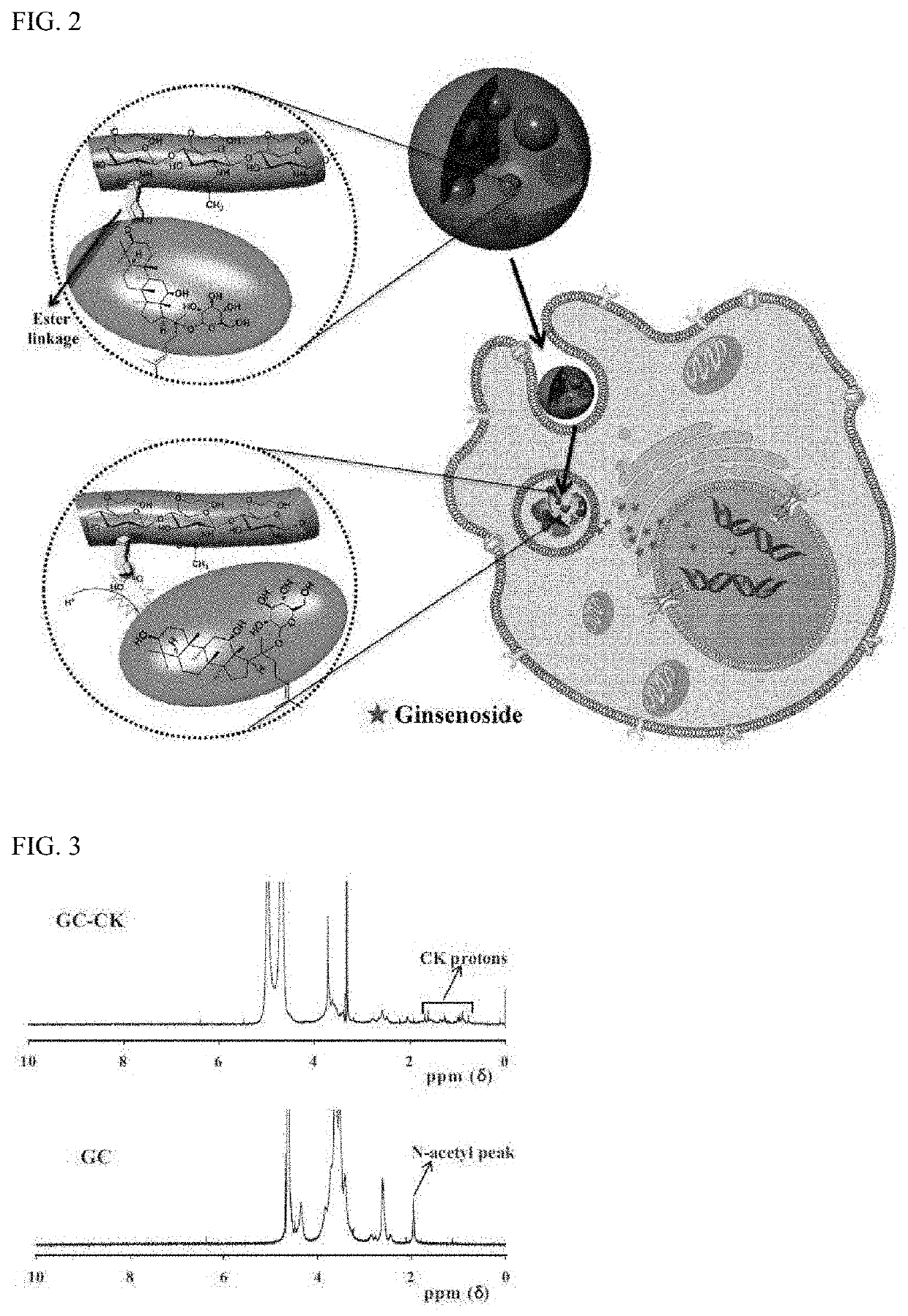Conjugate of ginsenoside compound k and glycol chitosan and an Anti-tumor use thereof
a technology of ginsenoside compound and glycol chitosan, which is applied in the direction of drug compositions, nanocapsules, capsule delivery, etc., can solve the problems of limited use of cancer chemotherapy, side effects, and cancer is a leading cause of death worldwide, and achieve excellent composition effects and increase water solubility
- Summary
- Abstract
- Description
- Claims
- Application Information
AI Technical Summary
Benefits of technology
Problems solved by technology
Method used
Image
Examples
example 1
[0062]Glycol chitosan (GC, Mw=4.3×105, degree of deacetylation=75.2%), N-hydroxyl succinimide, (NHS), succinic anhydride, 1-ethyl-3-(3-dimethylaminopropyl)-carbodiimide.hydrochloride (EDC.HCl) were purchased from Sigma-Aldrich (St. Louis, Mo., USA). Compound K (CK) was purchased from Ginseng Genetic Resource Bank (Kyung Hee University, Yongin, Korea).
example 2
of GC-CK Conjugates
[0063]A conjugate of ginsenoside CK and glycol chitosan (GC) was prepared by an ester linkage, which was hydrolyzed under acidic conditions to increase solubility and cancer cell specificity of hydrophobic ginsenoside CK and release CK for the purpose of treatment. The synthetic procedure used for this purpose are shown in FIGS. 1a and 1b. Further, the operating principle of GC-CK conjugate is shown in FIG. 2.
[0064]Specifically, the synthesis of GC-CK was achieved via a two-step process in which the carboxylated CK (CK-COOH) was prepared and conjugated to the GC through an amide bond (FIGS. 1a and 1b). CK (0.01 g, 0.016 mmol) was dissolved in 2 mL of pyridine / dichloromethane (1:1), to which succininc anhydride was added and reacted for 24 hours at room temperature. Then, the solvent was evaporated, precipitated, filtered, washed, and dried under vacuum to obtain CK-COOH powder. Next, GC (0.1 g, 0.53 mmol) was dissolved in 8 mL of distilled water and diluted with 2...
example 3
l Analysis of GC-CK Conjugates
[0065]The structures of the GC-CK conjugates were confirmed by 1H NMR and FT-IR to confirm whether the GC-CK conjugates were successfully prepared. NMR spectra were recorded at 300 MHz (JEOL, Tokyo, Japan). Each sample was dissolved in D2O or CD3OD. FT-IR spectra of the conjugates were recorded by a Perkin-Elmer FT-IR spectrophotometer using KBr pellets.
[0066]FIG. 3 shows 1H NMR data of GC-CK conjugates, which exhibits the characteristic peaks of GC and CK. The degree of substitution (DS), defined as the number of CK's in 100 repeating sugar units, was calculated based on the integration ratios of the proton peak appearing from the methyl group of CK at 0.68 ppm to that of the N-acetyl peak of GC at 2 ppm. Two types of GC-CK conjugates were prepared by varying the feed molar ratio of CK to GC. As expected, the DS increased as the feed ratio increased (i.e., for 0.1 and 0.2 molar ratio of CK, the conjugates with a DS of 4 and 9 were obtained, respectivel...
PUM
| Property | Measurement | Unit |
|---|---|---|
| diameter | aaaaa | aaaaa |
| pH | aaaaa | aaaaa |
| pH | aaaaa | aaaaa |
Abstract
Description
Claims
Application Information
 Login to View More
Login to View More - Generate Ideas
- Intellectual Property
- Life Sciences
- Materials
- Tech Scout
- Unparalleled Data Quality
- Higher Quality Content
- 60% Fewer Hallucinations
Browse by: Latest US Patents, China's latest patents, Technical Efficacy Thesaurus, Application Domain, Technology Topic, Popular Technical Reports.
© 2025 PatSnap. All rights reserved.Legal|Privacy policy|Modern Slavery Act Transparency Statement|Sitemap|About US| Contact US: help@patsnap.com



